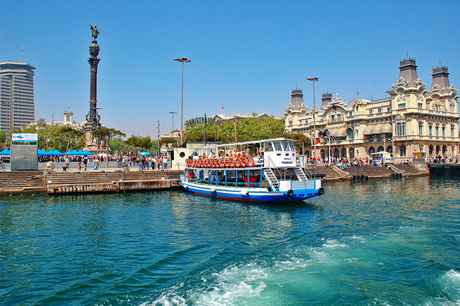Columbus Monument
The Christoffer Columbus Monument was built in 1888 in honor of the renowned explorer and discoverer of America. It consists of a statue of Columbus standing on a tall column. The Corinthian style made pillar is located on the Plaça del Portal de la Pau at the southern end of the Rambla. High up on the Monument is the actual monument, a statue of Colom (Columbus), which shows the direction of America.
At the center of the Plaça de la Porta de Pau (Square of the Gate of Peace) stands a monumental cast iron column set on a stone pedestal and topped by a statue of Christoffel Columbus. The 60m/197ft high monument, known as the Monument a Colom, was designed by the Catalan architect Gaietà Buigas i Monravà for the Universal exhibition of 1888. Construction of the monument started in 1882 but due to financial problems it was only completed just in time for the exhibition.
The monument is placed at the site where Christoffer Columbus arrived in 1493 after his discovery of America the year before. Columbus was presumably born in Genoa, Italy. He first moved to Portugal and later settled in Spain. Nevertheless in the 19th century Columbus was considered a Catalan - some historians still claimed he was born in Catalonia, hence the monument for the famous explorer in Barcelona.
The more than 7 meter high statue, created by Rafael Atche, shows a standing Columbus pointing towards the sea. Oddly enough, he is not pointing in the direction of the new world he discovered. The pedestal is beautifully adorned with a large number of allegorical figures.
The column and pedestal are hollow; you can access the monument, an elevator brings you to a platform from where you have an excellent view over the Rambla and Port Vell. You can book a hotel near the La Rambla after your flight to Barcelona and spend the day in touring the city, because it is better to visit the Columbus Monument at sunset, when people like to gather on the beach and have fun. Also, the view is better.
At the very top of the monument stands a 7.2 m (24 ft) tall bronze statue atop a 40 m (131 ft) tall Corinthian column. The statue was sculpted by Rafael Atché and is said to depict Columbus pointing towards the New World with his right hand, while holding a scroll in the left. As it was sited, instead of pointing to the west towards the New World, the statue points east towards Columbus's supposed home city of Genoa. The statue is atop a socle, on which the word "Tierra" (land) is inscribed.
The column, hung with a device bearing an anchor stands on an octagonal pedestal from which four bronze winged Victories or Phemes take flight towards the four corners of the world, above paired griffins. Four buttresses against the octagonal pedestal bear portrait medallions that depict people related to Columbus: Martín Alonzo Pinzón, Vicente Yáñez Pinzón, Ferdinand II of Aragon, Isabella I of Castile, Father Juan Pérez, Father Antonio de Marchena, Andrés de Cabrera, Marqués de Moya and Beatriz Fernández de Bobadilla, Marquessa de Moya. The base of the monument is a 20 m (66 ft) wide circle, with four staircases. Each staircase is flanked by two lions.
The idea of a monument to Columbus came in 1856 from Antoni Fages i Ferrer, who proposed that it be constructed entirely by Catalans, but he could not get anywhere with his plan for sixteen years. Finally in 1872 he gained the support of the mayor of the city, Francesc Rius i Taulet, and in 1881 the city passed a resolution to build the monument. A contest was held exclusively for Spanish artists to submit their designs with the winner being Gaietà Buigas i Monravà, a Catalan. Most of the money was privately raised, with only 12% being financed with public funds. All of the funding came from Spanish sources and the entire construction (labour and materials) was done by Catalans. Construction began in 1882 and was completed in 1888 in time for the Exposición Universal de Barcelona.
This is not so much a thing to do tip as a thing you can't really avoid tip. Getting on for 200 feet high, the Barcelona Colon, also called a number of other things (Monument a Colom, Monumento a Colón and Mirador de Colón for a start) is a huge and impressive edifice at the "bottom" end of the Ramblas towards the sea and is difficult to miss. It should be at the sea because it commemorates the return of Christopher Columbus to Barcelona after "discovering" the Americas in 1492 and herein lies a clue to the title of this tip.
Columbus did not discover the Americas, despite what you might have been taught in school. He was beaten there by Giovanni Caboto, better known as John Cabot who has a similarly imprerssive monument and a pleasant seaward-lookinngstatue in Bristol in the United Kingdom. However, even Cabot wasn't the first European there as current scientific thinking credits the Vikings with doing it centuries before.
All this is, however, to quibble, and the monument is well worth a visit. It was built between 1882 and 1888, when it was opened for the Exposition and is to the design of Gaietà Buigas i Monravà. There is a whole world of imagery involved here from the statues and some wonderful bas relief. You can get there via direct flight to Barcelona or to Girona, Reus or Lleida–Alguaire.
The Columbus Monument offers great view to the sea, so it's a favourite place to go and have a rest, while the sun sets. Lots of tourist like to take photos of the beautiful sight in the end of the day after a long day of traveling and sightseeing in Barcelona.




